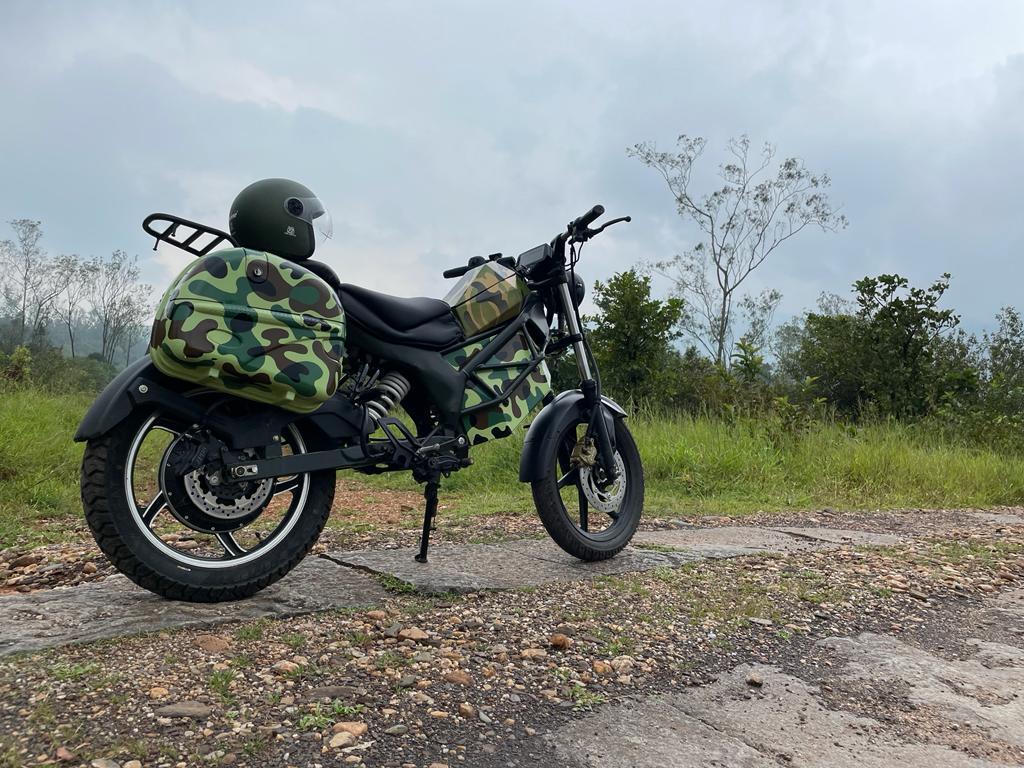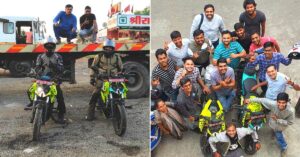NIT Karnataka Designs Solar-Powered E-Bike for Forest Guards’ Surveillance Trips
Professor U Pruthviraj, the Head of E-Mobility Projects at the Centre for System Design at NITK, Surathkal, and his team of students have built the VidhYug 4.0 e-bike that forest guards can use to monitor their surroundings.

Professor U Pruthviraj, who currently heads e-mobility projects at the Centre for System Design (CSD) under the National Institute of Technology Karnataka (NITK), Surathkal, and his team of students have developed the VidhYug 4.0 electric bike (e-bike) for forest surveillance.
Unveiled during the ‘Shola Utsav’—organised by the Kudremukh Wildlife Division on 17 November 2021 to raise awareness on the importance and conservation of Shola forests—to senior forest department officers, the e-bike has garnered much praise for their reliability in a forest marked by steep inclines and rough terrain.
“Prior to the event, we were in constant touch with Professor Pruthviraj and his team about our requirements, how the electric bike should be modeled and ways it can be made more useful on the field, etc. The e-bike they demonstrated was very good, completely silent and powerful enough. Usually with electric vehicles there are concerns about reliability. In terms of usability and reliability we are convinced of the e-bike’s capabilities. However, we are not currently using it for surveillance. The decision to purchase it rests with the government, but based on the trials we have observed it’s performing well,” says Ruthren Periyasamy, Deputy Conservator of Forests, Kudremukh Wildlife Division, Karkala, speaking to The Better India.
Inspiration in Silence
During his 11-year association with the Kudremukh Wildlife Division in different capacities, Professor Pruthviraj had noticed many IC-engine vehicles making their way into the forest for patrolling. For kilometres together, forest officials have to go on patrolling from one location to another, but their IC-engine motorbikes make a lot of noise and generate air pollution.
“The Kudremukh Wildlife Division, which is home to the vast shola forests and prominent flora and fauna, lies about nearly 100 km east of our college campus. Given the pristine nature of the forest, I thought we could introduce e-mobility here. After all, patrolling the forest necessitates silence. So, instead of simply constructing an e-bike for our college campus, we thought why not modify it and make one for the forest department. When we approached them with an idea to make an e-bike for forest surveillance, they gave us the green signal to test and use it there,” says Professor Pruthiviraj.
Steevan Loyd, a junior research fellow with CSD at NITK who worked on this project, describes how they proceeded with the process of designing and developing it.
“To design the e-bike, we first went to the forest department, took note of their requirements like a headlight doubling up as a torch light, different storage options, and charging docks, etc. We then began the process of coming up with a concept design using tools we learnt during our engineering courses like CAD (computer-aided design) and 3D-Printing. Following this, we did calculations on the amount of power, torque and speed we need to climb the steep inclines and rough terrain in Kudremukh. Once we included these calculations in the e-bike design, we conducted a static analysis on the same to see whether it’s capable of taking this load or not. We then gathered all the materials needed to build this e-bike, put them together and came up with our prototype. Later, we took it to the Kudremukh Wildlife division for testing, where the officers rode it,” he recalls, adding that they also implemented the feedback from the officers.
Professor Pruthiviraj and his team began designing and developing the VidhYug 4.0 during the second COVID-19-induced lockdown.
“My students were quite literally living in the laboratory for one week at a time before taking a three-day break in their hostels and then coming back to work. I would bring food for my students while there was also a small cafeteria at the department as well for them. We spent about four to five months in the fabrication stages, testing the e-bike on the college campus,” recalls Professor Purthviraj.
Fortunately for the students, their workload was relatively less at the time considering that no classes were happening. There was little to no academic stress, and thus all of them were fully focussed on making this one product. In about four to five months, the basic model of the e-bike was ready, following which they painted it and adjusted a couple of things. Within about seven to eight months, the product was fully functional and ready to use.
“It didn’t look like a product usually made by students. It was fully-finished, painted and ready to go on the field,” he says, adding, “We took a lot of care in ensuring the e-bike is neat, ridable, and comfortable, with room for making more improvements, if needed.”

Features of the VidhYug 4.0
For regular patrolling, forest officials are using standard IC-engine bikes that make noise, and scare the wildlife away. This e-bike is relatively very silent other than the friction between the tyre and the road. One of the interesting features of this bike is the installation of its headlight.
“This looks like a regular bike headlight, but if you remove and unplug it it works like a torch or a searchlight. Usually, forest guards will have a torch with them which they need to charge it. They often charge their torches at an anti-poaching camp, for example. Here, there is an in-built battery in the headlight which receives charge from the built-in battery of the e-bike,” he says.
In other words, forest guards can use the e-bike beyond conventional transport. If there is a location beyond which they can’t use their vehicle and need to walk, that headlight can be used as a torch. They’ve also added a utility box, which contains two 12V charging ports—one for their walkie-talkie system and the other for their handheld GPS system or a mobile phone.
The e-bike also has a pannier box in the rear containing a jerry can carrying fresh water from the streams to anti-poaching camps or the watch towers, and on the other side there is a waterproof compartment where they can store some ration or log books.
“The ‘VidhYug 4.0’ is powered by a 2kW BLDC motor and 72 volts, 33 AH lithium-ion battery. Kudremukh is known for its rough, muddy terrain with steep inclines, and this e-bike has the requisite power to drive in these parts. We can swap tyre types as well to improve performance on the ground. It’s also camouflaged, and we have avoided fancy stickers, side indicators, etc. We have embedded only bare minimum features on the e-bike. As of now, the battery range is about an average of 70 km on a single charge of 3-4 hours, although we will not say that our testing is sufficient,” claims Professor Pruthiviraj.
Given their continuous one and a half week testing in the forest, taking a break, and testing again for the same period, and repeating that process multiple times, the project team arrived at the claimed battery range. On a pucca road, the range would be sufficiently more. “The e-bike top speed is approximately 70-80 kmph, offers 63NM torque and we have installed disc brakes in it as well,” he adds.
The forest division has anti-poaching camps and watch towers, where the team has installed charging docks powered by solar panels.
“The solar charging setup includes two 400 watt mono crystalline solar panels and a 1.5 kw UPS unit for charging the battery. We have even provided additional batteries for the solar charging system so that if for four or five days there is no sunlight, the charging system can still function well. In Kudremukh, fortunately, most anti-poaching camps are exposed to sunlight since they need charging systems for their devices like wireless walkie-talkies and electricity at night. With the e-bike, we have also provided a standard 230V charging system that can be plugged in a nearby village or town as well which has electricity,” he says.

Proper Learning Through Engineering
“We learnt a lot in the designing and development of this e-bike which otherwise wouldn’t have happened in a classroom from material procurement, designing, analysis of the frame to how the product should present itself, etc. During our engineering course, we study technology like 3D Printing and CAD tools, but in this project we actually implemented it,” says Steevan.
Rajath C Kotekar, a fellow junior research fellow at CSD, also shares the same sentiment. “In colleges, we would not make end-use, good quality products,” he says.
So far, the team has received many inquiries for the VidhYug4.0 from industry, claims Pruthiviraj. But as an academic institution NITK can’t sell any product.
“We are looking forward to knowledge transfer to any startup. A few companies have come forward so far. The college administration is yet to take a call on it. Once this knowledge is transferred out to a startup, a lot more testing needs to be done, besides offering maintenance, servicing, etc. We are also getting many calls from different organisations working with forests,” says Professor Pruthviraj.
(Edited by Yoshita Rao)
Like this story? Or have something to share? Write to us: [email protected], or connect with us on Facebook and Twitter.
If you found our stories insightful, informative, or even just enjoyable, we invite you to consider making a voluntary payment to support the work we do at The Better India. Your contribution helps us continue producing quality content that educates, inspires, and drives positive change.
Choose one of the payment options below for your contribution-
By paying for the stories you value, you directly contribute to sustaining our efforts focused on making a difference in the world. Together, let's ensure that impactful stories continue to be told and shared, enriching lives and communities alike.
Thank you for your support. Here are some frequently asked questions you might find helpful to know why you are contributing?


This story made me
-
97
-
121
-
89
-
167














